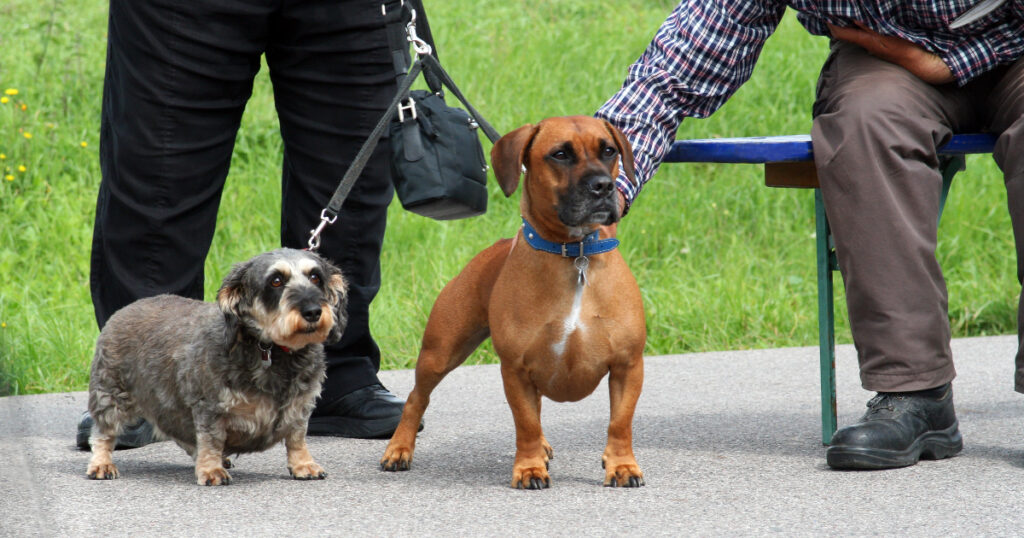For pet parents with multiple dogs, walking them together can be a tangled mess. Trying to manage two leashes while your dog’s zig and zag can quickly turn an enjoyable outing into a frustrating chore.
Double dog leashes promise to solve this problem by coupling two leashes together into one convenient lead. But are these clever contraptions right for your dog duo?
Here’s what you need to know about the pros and cons of double dog leashes.
The Pros and Cons of Using Double Dog Leashes
Walking two dogs at once can be challenging, especially if they have a tendency to pull on their leashes. Many pet owners turn to double dog leashes to make managing multiple dogs easier. Double dog leashes couple two leashes together, allowing you to hold one lead instead of two.
While double dog leashes seem convenient, they also have some potential drawbacks to consider. Looking at the pros and cons can help you decide if a double dog leash is right for your needs.
Not Enough Space Between Dogs

One of the main complaints about double dog leashes is that they don’t provide enough space between dogs. Most double dog leash couplers only allow 1-2 feet between dogs. This can feel cramped during long walks.
Some dogs may get anxious being so close, even if they cohabitate peacefully at home. Having limited personal space can cause tension and even redirected aggression if one dog gets excited or scared.
Conversely, a longer double dog leash could give your dogs ample room to sniff, potty, and move comfortably. Look for an adjustable double coupler that extends up to 6 feet to provide more space between your pets.
Challenging for Different-Sized Dogs
Attaching a large and small dog together on a short double leash can be frustrating for both pets. The size difference forces the smaller dog into an exhausting trot to keep pace. And the height difference creates constant collar pulling on the larger dog.
Look for a double dog leash with adjustable-length couplers. This allows you to size each section appropriately for your specific dogs. Make sure it can extend long enough to accommodate a big height difference.
Some double dog leashes come in different sizes for small, medium, and large breeds. This tailored sizing can provide a better fit.
Limited Control
Holding one lead for two dogs may seem like added control. But in reality, a double dog leash can make it hard to handle unruly canines. Two dogs pulling in opposite directions or towards each other can overpower the walker.
Experts recommend double dog leashes only for well-trained dogs who don’t pull hard. For powerful pullers, separate leashes give you more direct control over each dog.
Using a double dog leash is also risky if one dog has good leash manners and the other does not. The bad leash walker will still be able to drag both dogs around.
Accidents and Tangling
Dogs wandering to opposite sides on a double leash increase the risk of tangling their legs or bodies. This can cause falls or injuries. Longer leads reduce, but don’t eliminate this hazard.
Getting leashes wrapped around furniture or poles is another concern. Two leashes already create more opportunities for tangling. Connecting them together just enhances this problem.
Paying close attention to avoid hazards can help prevent accidents. But it’s another thing to be vigilant about when handling two dogs.
Difficult to Correct Individual Dogs
A major limitation with double dog leashes is the inability to correct one dog’s behavior without restricting the other dog. If one dog misbehaves, you cannot give leash corrections or move that individual away from a trigger without control of the entire pair.
With two separate leashes, you have the flexibility to work with each dog independently. You can issue leash corrections, change direction, speed up, or slow down for one dog as needed.
Safety Concerns Around Other Dogs
Attaching two friendly dogs who live together is one thing. But using a double dog leash around unfamiliar dogs poses risks.
If one of your dogs reacts aggressively on a leash, the other dog tethered right next to them is forced into the confrontation too. Being tied together limits their ability to move away.
And restraining two dogs trying to lunge toward another dog is nearly impossible. For safety, leashing reactive dogs separately allows better control over each one.
Alternatives to Consider for Multi-Dog Walking
If you want to walk two dogs at once but are unsure of a double dog leash, consider these options:
- Use separate leashes, one in each hand. This allows the most control but requires coordination.
- Attach leashes to your waist belt to keep two dogs hands-free. Make sure to get a sturdy walking belt designed for dogs.
- Consider a splitter leash with one lead that splits into two at the bottom. This still provides individual control.
- Try a coupler lead on one dog, then a standard leash on the second. Mixing leash types gives you combined and separate control.
- Use double dog leashes only in low-distraction areas until dogs are totally comfortable walking politely side-by-side.
The Benefits of Double Dog Leashes
Despite some limitations, double dog leashes can be a useful tool for multi-dog homes. Benefits include:
- Greater convenience by only holding one leash
- Reduced tangling since leashes connect via a swivel or coupler
- Allows dogs to walk together and enjoy joint exercise
- Freedom to have one hand free for phones, bags, or dog waste
- Prevents dogs from crossing leashes and getting tangled
- Easier for professional dog walkers to handle multiple dogs
For dogs with solid leash manners who walk well together, a double dog leash can simplify multi-dog walks. But work on loose leash training first before making the leap to a double leash. A proper introduction to double leashes is also key to preventing frustration. With patience and the right equipment, you may find managing two dogs on a leash is surprisingly easy.
Tips For Using Double Dog Leashes
If you decide to try a double dog leash, keep these tips in mind:
- Choose an adjustable double leash to customize fit and spacing
- Practice first in low-distraction environments
- Attach the leash to proper training collars for added control
- Use high-value treats for motivation and reinforcement
- Avoid high-traffic areas until dogs are pros at polite walking
- Pay close attention to hazards and tangling risks
- Be prepared to drop back to two separate leashes if needed
- Don’t force dogs together on a double leash if they clearly don’t enjoy it
- Work on loose-leash walking skills before making the switch
FAQ
What are some alternatives to double dog leashes?
If a double dog leash doesn’t seem like the best fit, consider these alternatives for walking two dogs:
- Use two separate leashes, one in each hand. This allows maximum control of each dog individually. But it does require coordination and untangling skills.
- Attach leashes to your waist belt to keep your hands free. Get a sturdy dog walker belt designed for this purpose.
- Try a splitter leash that has one lead at the top and then splits into two at the bottom. You maintain some separate control.
- Use a coupler lead on one dog and a standard leash on the second. This mixes total control and combined walking.
- Let one dog wear a harness and the other a collar leash for different control options.
How can I introduce dogs to a double leash?
A proper introduction sets your pups up for success. Follow these tips:
- Start in a low-distraction area like your home or yard before going on real walks.
- Ensure both dogs have mastered loose leash walking separately first.
- Give treats and praise for polite walking side-by-side on the double leash.
- Walk for short intervals and don’t force dogs together if they seem unhappy.
- Use commands like “let’s go” to reinforce keeping pace together.
- If needed, drop back to separate leashes and work more on training.
What precautions should I take with a double dog leash?
Using a double leash safely takes extra awareness:
- Select a longer double leash to provide ample space between dogs.
- Adjust lead lengths to suit your dog’s size difference.
- Watch for tangling hazards like furniture and poles.
- Avoid high-distraction areas until dogs walk politely together.
- Be prepared to leash reactive dogs separately.
- Never tie dogs unsupervised on a double leash.
Conclusion
While joining your dogs together on one leash may sound like a walk in the park, double dog leashes have pros and cons to weigh.
Used properly on trained pups, they can simplify multi-dog walks. But individual control and safety should remain top priorities. Determine your dogs’ personalities and your own handling capabilities to choose if a double dog leash suits your needs.
With the right precautions, you may find this clever creation makes enjoying walks with your pair of pooches easy as one, or two, walk!

